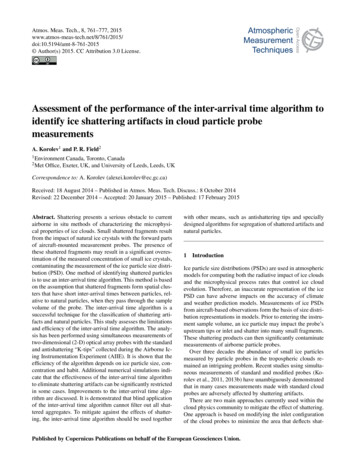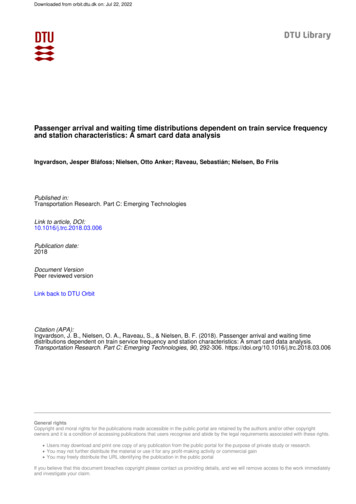
Transcription
Downloaded from orbit.dtu.dk on: Jul 22, 2022Passenger arrival and waiting time distributions dependent on train service frequencyand station characteristics: A smart card data analysisIngvardson, Jesper Bláfoss; Nielsen, Otto Anker; Raveau, Sebastián; Nielsen, Bo FriisPublished in:Transportation Research. Part C: Emerging TechnologiesLink to article, DOI:10.1016/j.trc.2018.03.006Publication date:2018Document VersionPeer reviewed versionLink back to DTU OrbitCitation (APA):Ingvardson, J. B., Nielsen, O. A., Raveau, S., & Nielsen, B. F. (2018). Passenger arrival and waiting timedistributions dependent on train service frequency and station characteristics: A smart card data analysis.Transportation Research. Part C: Emerging Technologies, 90, 292-306. https://doi.org/10.1016/j.trc.2018.03.006General rightsCopyright and moral rights for the publications made accessible in the public portal are retained by the authors and/or other copyrightowners and it is a condition of accessing publications that users recognise and abide by the legal requirements associated with these rights. Users may download and print one copy of any publication from the public portal for the purpose of private study or research. You may not further distribute the material or use it for any profit-making activity or commercial gain You may freely distribute the URL identifying the publication in the public portalIf you believe that this document breaches copyright please contact us providing details, and we will remove access to the work immediatelyand investigate your claim.
Passenger arrival and waiting time distributions dependent ontrain service frequency and station characteristics: A smart carddata analysis
AbstractWaiting time at public transport stops is perceived by passengers to be more onerous than actualin-vehicle time, hence it largely influences the attractiveness and use of public transport. Transportmodels assume traditionally that average waiting times are half the service headway by assuming random passenger arrivals. However, research agree that two distinct passenger behaviour types exist: onegroup arrives randomly, whereas another group actively tries to minimise their waiting time by arrivingin a timely manner at the scheduled departure time. This study proposes a general framework for estimating passenger waiting times which incorporates the arrival patterns of these two groups explicitly,namely by using a mixture distribution consisting of a uniform and a beta distribution. The frameworkis empirically validated using a large-scale automatic fare collection system from the Greater Copenhagen Area covering metro, suburban, and regional train stations thereby spanning service frequenciesfrom 2-60 minutes. It was shown that the proposed mixture distribution is superior to other distributionsproposed in the literature. This can improve waiting time estimations in public transport models. Theresults show that even at 5-minute headways 43% of passengers arrive in a timely manner to stationswhen timetables are available. The results bear important policy implications in terms of providingactual timetables, even at high service frequencies, in order for passengers to be able to minimise theirwaiting times.2
KeywordsAutomated fare collection data; Smart card; waiting time; public transport; frequency-basedtimetables; mixture distributions.3
Highlights Passenger waiting times are modelled as a uniform and beta mixture distribution Validated framework that can improve waiting time estimations in transport models Results show that many passengers arrive in a timely manner to stations even at short headways Results highlight the importance of published timetables4
1IntroductionWaiting time at public transport stops is perceived by passengers to be more onerous than in-vehicle time (Nielsen, 2000; Fan et al., 2016; Fosgerau et al., 2007). Reducing waiting time is thereforeof great importance when designing public transport systems. For en-route transfers this can be achievedby optimising public transport timetables in order to ensure short transfers (Parbo et al., 2014). However, this only affects transferring passengers which in the Greater Copenhagen Area corresponds to45% (Christiansen, 2015). For all passengers it is also important to consider the waiting time experienced pre-route at the departure stop so that passengers can actively reduce their waiting time.In general, when timetables are available to passengers, two distinct types of travel behaviourare observed when arriving to a departure stop: i) one group arrives randomly, and ii) a second groupwill try to minimise the waiting time by arriving in a timely manner at the scheduled departure time(Csikos and Currie, 2008; Frumin and Zhao, 2012; Jolliffe and Hutchinson, 1975; Luethi et al., 2007).The shares of the two groups are influenced by service characteristics such as headway and reliabilityas well as other factors, such as time of day (Csikos and Currie, 2008; Frumin and Zhao, 2012; Luethiet al., 2007; Nygaard and Tørset, 2016). As headway or reliability decreases, the share of passengersarriving randomly increases as the potential benefit of reduced waiting time is reduced (Bowman andTurnquist, 1981). Capturing such behaviour accurately in transport models is important for estimatingimpacts of public transport investments. However, most traditional public transport assignment modelsassume all passengers to arrive randomly to the stop, hence assuming the average waiting time to behalf the headway (Fu et al., 2012; Nielsen, 2000; Nökel and Wekeck, 2009; Schmöcker et al., 2011;Szeto et al., 2013, 2011). Therefore such models might overestimate waiting times as more passengerswill time their arrival at the station leading to lower actual waiting times (Csikos and Currie, 2008).This paper contributes to the existing literature by analysing a large-scale empirical data set ofpassenger arrivals and waiting times at train stations in the Greater Copenhagen Area. The contributionis three-fold.Firstly, this study proposes a general methodology to model passenger waiting times at publictransport stations by explicitly taking into account passengers arriving randomly and non-randomly.The methodology is an extension of the approach proposed in Luethi et al. (2007) where the arrivalpatterns of passengers were modelled as a mixture of a uniform and a Johnson SB distribution, thustaking into account random and non-random passenger arrivals, respectively. In this present study themethod is further developed by proposing a general mixture of a uniform and a beta distribution whichcan be fitted to specific service frequencies by adjusting the share of uniform passenger arrivals as wellas the parameters for the beta distribution. The simple and general formulation makes it easily adoptablein public assignment models.Secondly, data used for this study is based on a large-scale automated fare collection (AFC)system containing more than 1.5 million trips covering all modes of public transport in the Greater5
Copenhagen Area during September and October 2014. This allows for extending the work of Fruminand Zhao (2012), which deployed a large-scale AFC dataset from the London Overground to analysepassenger arrivals at boarding stations at headways in the range 7-30 minutes. This present study coversstations with headways ranging from 2 minutes on the metro to 60 minutes on regional train lines. Inaddition, it includes modes with traditional published timetables (suburban and regional trains) andfrequency-based timetables where actual departure times at stations are not published (metro). Thismakes it possible to compare results across a wide range of service frequencies and timetable types.Thirdly, this study takes into account the effects of multiple station characteristics on the arrivalpatterns and waiting times of passengers. This data is joined onto databases including information onstation layouts, station amenities and land use types surrounding the stations. This makes it possible toestimate the importance of such characteristics on passenger waiting times.The paper is organised with a review of the existing literature on analysing passenger waitingtimes in public transport in section 2. The methodology and data used in this study is described insection 3 while the results are presented and discussed in section 4. In section 5 conclusions are drawnwhile policy implications are highlighted in section 6.22.1Literature reviewEstimation of waiting timesSome of the earliest studies focusing on passenger arrival patterns analysed the relationshipbetween waiting time and headway by a simple linear relationship. O’Flaherty and Mangan (1970)found that average passenger waiting time, W, could be related to average bus headway, h (measuredin minutes) by the simple linear relationship W 1.79 0.14h during an evening peak period in Leeds,UK. Seddon and Day (1974) improved the simple model by adding the influence of random bus arrivals.In their study the relationship was found to be W 2.34 0.26h (measured in minutes) for stops inManchester during both peak and off-peak hours. Hence, evidence of non-random arrivals were foundas random arrivals would have implied W 0.5h. Jolliffe and Hutchinson (1975) further improved theestimation of passenger waiting times by analysing the influence of day-to-day variability of bus arrivals. The study also proposed a three-fold categorisation of passengers based on their behaviour: i)those who arrive to minimise their waiting time, ii) those who arrive randomly, and iii) those whosearrival coincides with the bus, i.e. by running to catch it. Based on an analysis of ten bus stops withvarying headways at 6-31 minutes in London they found that actual passenger waiting times were 30%less than if passengers arrived randomly. Bowman and Turnquist (1981) extended the estimation ofpassenger waiting times by modelling explicitly the arrival distribution of passengers timing their arrival at stops by using a decision model of arrival time choice to the bus stop. By using this model thestudy found that passengers are more sensitive to reliability than to scheduled headway when decidingbetween arriving randomly or timing their arrival.6
Later studies investigated aggregate passenger arrival patterns with the purpose of estimatingthe threshold for when passengers arrive randomly. Fan and Machemehl (2002) found that 10 minuteheadway was the limit between random and non-random passenger arrivals based on 2,491 observationsof bus passengers from Austin, Texas. In a later study, the same authors found that 11 minutes was thetransition point between practically random arrivals to less random arrivals, and that all passengerstimed their arrival at headways of over 38 minutes (Fan and Machemehl, 2009). Similar results werefound in a study on bus passenger arrivals in Trondheim, Norway, where passengers were found to timetheir arrival at headways of 10 minutes (Nygaard and Tørset, 2016). These studies only analysed arrivalpatterns of bus passengers. Luethi et al. (2007) analysed passengers across public transport modes, i.e.bus, tram, and commuter rail based on data from Zürich, Switzerland. The study estimated the thresholdfor random arrivals even lower at 5 minutes for which a significant group of passengers timed theirarrival. This study also found that the share of passengers arriving non-randomly was higher at 5-minuteheadways than at 6-minute headways, hence highlighting the importance of timetables that are easy toremember.In a more recent study, Frumin and Zhao (2012) investigated passenger arrival patterns using alarge-scale AFC dataset from the London Overground rail network finding that a notable share of passengers arrive in a timely manner at all analysed headways (7-30 minutes). The study distinguishedbetween two types of passenger behaviour, namely timetable-dependent passengers arriving accordingto the timetable and passengers arriving randomly. Hence, instead of reporting a transition headway forwhen passengers arrive randomly, the study found that the share of passengers arriving randomly variedacross the network and time-of-travel as more passengers arrived randomly at longer headways and atservices with known reliability problems. The explicit two-fold arrival behaviour of passengers weresubsequently used to evaluate service quality in terms of actual realised (and excess) journey times(Zhao et al., 2013), and to evaluate the effects of a timetable change on a rail line of the London Overground network (Frumin et al., 2013).Several studies investigated the properties of the arrival patterns using statistical distributions.Luethi et al. (2007) proposed an advanced framework for modelling passenger arrivals using a mixtureof uniform and Johnson SB distributions, hence explicitly taking into account the two-fold representation of the arrival behaviour of passengers. Several later studies have used a simpler approach. Ananalysis of transferring passengers were conducted in Beijing showing that the lognormal and gammadistributions had the best fit for direct and non-direct passengers, respectively (Guo et al., 2011). And,at Beijing bus stops Gong et al. (2016) found that gamma and lognormal distributions best fitted passenger waiting times during evening peak hours. Nygaard and Tørset (2016) analysed bus stops with10-20 minute headways in Trondheim, Norway. They concluded that passenger arrivals were non-uniform without giving further details on alternative descriptions. While focusing explicitly on passengerarrival patterns, Frumin and Zhao (2012) and Zhao et al. (2013) did not focus explicitly on the statisticalproperties of the passenger arrival distributions.7
The influence of travel and station characteristics on waiting times has also been the focus ofrecent research. Fan and Machemehl (2009) investigated the influence of stop location, gender andtravel period, but did not find any effect on waiting times. However, the study found that passengerswith car as access mode wait shorter than others. Currie and Csikos (2007) found time-of-day effectsas random passenger arrivals were more common during off-peak hours as compared to travellers during peak hours. Similar results were found in Luethi et al. (2007) where travellers during morning andafternoon commute periods experienced shorter waiting times than those travelling mid-day. The studyalso found lower average waiting time for passengers at stations where the perceived service reliabilitywas high, hence highlighting the importance of reliable operations. However, each station only hadobservations for one time period, hence the effect could be related to the station rather than the timeperiod. The study suggested further research on the topic including the effects of time-of-day, routereliability, travel purpose, station location (in network), station environment, and previous activity(work, school, etc.). In a more recent study Fan et al. (2016) found significant effects of station amenities and perceived safety on the perceived waiting time using data from 36 light rail, commuter rail andbus stops in the Minneapolis-Saint Paul metropolitan area. If stations had limited amenities in terms ofshelters and benches the waiting time was perceived 30% longer, and for women waiting in insecureplaces for more than 10 min the wait was perceived as much longer.While these studies have investigated waiting times in detail across various study areas withdifferent public transport structures including the influence of service frequency and station characteristics most studies rely on manual data collection making sample sizes for specific combinations ofmode, time-of-day and service frequency relatively small. Only few studies deployed large-scale AFCdata, but did not focus explicitly on the properties of the waiting time distributions. Furthermore, moststudies relied on data covering only one mode of public transport, most often buses or single rail lines.2.2Implementation in transport modelsThe first studies on public transport assignment models implemented passenger arrival patternsat departure stops simply by the so-called half-headway approach (Clerq, 1972; Dial, 1967). This approach relies on three important assumptions: i) deterministic transit vehicle headways hence assumingperfect service regularity, ii) passengers can board the first arriving vehicle, and iii) random arrival ofpassengers at stops (Fan and Machemehl, 2002). The first two assumptions are related to the operationsof the public transport system which are not the main focus of this paper. A description of these assumptions can be found in Gentile et al. (2016). The third assumption is related to the travel behaviourof passengers which in this case are assumed to not consider the timetable of the public transport service.Hence, the average of the waiting time is estimated to be half the headway. The simplicity made theapproach very popular resulting in wide usage within assignment models (Ceder and Marguier, 1985;Hess et al., 2004; Liu et al., 2010). This includes most frequency-based transit assignment models (Fuet al., 2012; Nökel and Wekeck, 2009; Schmöcker et al., 2011; Szeto et al., 2013, 2011).8
However, as previous research states random passenger arrivals can only be reasonably assumed at short headways. Hence, such models might overestimate average waiting times as more passengers will time their arrival at the station (Csikos and Currie, 2008). Therefore, other transit assignment models assume half headway for short frequencies with a maximum waiting time for longer headways, e.g. the schedule-based model suggested in Nielsen (2000), thus resolving the issue slightly. Inother schedule-based models the waiting time is modelled implicitly as part of the departure time choiceof passengers based on the timetable of the public transport system (Nielsen, 2004; Nielsen &Frederiksen, 2006; Gentile et al., 2016; Nuzzolo et al., 2001). However, actual passenger arrivals atstops, and hence actual passenger waiting times, are not affected by the timetable due to high servicefrequency (Nuzzolo et al., 2015, 2012, 2001). By this, both model types do not accurately take intoaccount the actual passenger arrival patterns and waiting time distributions, thus highlighting the needfor a simple approach to estimate passenger waiting time patterns.3MethodologyThe framework developed in this study was to analyse passenger waiting time distributionsusing AFC systems. Such data are being used more and more for various public transport planningpurposes (Pelletier et al., 2011). Specifically, this analysis was tailored to investigate explicitly the ratiobetween passengers arriving randomly and those arriving non-randomly. This can be modelled by amixture distribution holding two distributions which was first introduced in Luethi et al. (2007).Passengers who do not consider the timetable are assumed to arrive according to a Poissonarrival process. Hence, they arrive randomly to stations and their waiting times follow the uniformdistribution as also suggested in several studies (Fu et al., 2012; Luethi et al., 2007; Nielsen, 2000;Nökel and Wekeck, 2009; Schmöcker et al., 2011). The other group of passengers who do consult timetables will arrive with varying arrival intensity as this group of passengers will try to minimise theirwaiting time by arriving close to the departure time. The waiting time distribution will therefore notfollow a uniform distribution. Instead this study proposes that the waiting time distribution of this groupof passengers can be described by a beta distribution. This was done because the beta distribution possesses three important characteristics;1. It is bounded on a defined interval which fits with the operational characteristics of public transportwhere passengers’ waiting times are bounded by the service headway.2. The beta distribution can handle the specific characteristics of passengers knowing the timetable.Namely, that they are assumed to add a buffer time to their arrival time at stations in order to notmiss the departure (Fonzone et al., 2015; Frumin and Zhao, 2012). As the buffer time varies acrosspassengers and service frequency, the arrival intensity is assumed to be highest a few minutes beforethe departure time and be decreasing towards the time of the next departure, cf. Figure 1. The shapeparameters of the beta components (α and β) can explicitly model this as they define the skewnesswhich might also vary across service frequency.9
3. The uniform distribution is a special case of the beta distribution. By this there is a strong linkbetween the distribution of the random passenger arrivals and those arriving according to the timetable.Hence, with 𝛤(𝑧) denoting the gamma function defined as 𝛤(𝑧) 0 𝑥 𝑧 1𝑒 𝑥 𝑑𝑥 , the probabilitydensity function (PDF) of the mixture distribution, 𝑓(𝑥), proposed by this study can be written as:𝑓(𝑥) 𝜍 𝛤(𝛼 𝛽) 𝑥 𝛼 1 (1 𝑥)𝛽 1 (1 𝜍)𝛤(𝛼) 𝛤(𝛽)(1)The ς denotes the proportion of the beta component whereas (1 - ς) denotes the proportion ofthe uniform component. Figure 1 shows the PDF with the y-axis denoting the density and the x-axisdenoting the normalised waiting time (i.e. share of full headway).[Place Figure 1 about here]Maximum likelihood estimation was used to fit the waiting times calculated from the AFC datato the specified mixture distribution framework using the R statistical software package (R Core Team,2017). This was done for all headways in the data (2/3/4/6/10 minutes for metro, 5/10/20 minutes forsuburban trains, and 20/30/60 for regional and intercity trains). By this, a mixture distribution for eachheadway was estimated including the share of observations contained in the uniform and beta parts,respectively. Finally, the fit was compared to that of a mixture distribution containing one part uniformand one part Johnson SB distribution as proposed by Luethi et al. (2007) to evaluate the methods.3.1Case study: Greater Copenhagen AreaThe study area covers the commuting area1 of Copenhagen in the eastern part of Denmark inwhich approximately 2 million people live. The study utilised the Danish Rejsekort (English: Travelcard) which is a tap-in-tap-out AFC system. This holds information on when and where passengerscheck into and out from the public transport system as well as intermediate transfer locations. Thesystem covers all modes of public transport in Denmark, i.e. buses, metro and railways, and is used formore than 100 million trips annually (Rejsekort A/S, 2017). However, not all passengers use it for alltrips as monthly passes are not currently implemented in the card. Hence, most commuting trips are notincluded in the data. For this study a data sample covering 1,767,858 public transport trips for themonths of September and October 2014 was utilised corresponding to 12% of all public transport tripsduring that period.The AFC data was linked to timetable data for suburban trains (S-trains) and regional trains inorder to calculate the waiting times for passengers. For metro trains no public timetable is available dueto the system running at high service frequency, i.e. every four minutes during rush hour, every sixminutes during other hours, and every 10-20 minutes during the night. As the two metro lines run partlyin parallel service frequency is doubled within the city centre. Hence, for the metro a synthetic timetable1This also includes towns located throughout Zealand from which extensive commuting patterns towards Copen-hagen, e.g. Kalundborg, Korsør, and Vordingborg.10
based on the time-of-day-dependent service frequency was produced in order to calculate waiting timesfor metro passengers.The effects of various travel and station characteristics on waiting time distributions were analysed using different data sources, cf. Table 1. Station characteristics were taken from a study on transferattributes (Dyrberg and Christensen, 2015). This included whether stations were located undergroundor had platform shelters to protect from weather, and a subjective measure of station layout rankingstations in terms of wayfinding. The inclusion of this measure was not straight-forward, but was included to analyse whether stations with simple layout and easy access to platforms from the street levelinfluenced passenger arrival behaviour. In addition, detailed land use data comprising 44 categories ofland use types were tested and eventually aggregated into only two types, i.e. leisure and commute. Bythis, land use types such as offices, industry and residential areas were categorised as being related tocommuting travel whereas land uses such as nature, recreational areas, shopping and cultural institutions were categorised as leisure. For each station the land uses within 500 meters of the station wereidentified since the Danish travel survey suggest that the mode share of public transport is notablyhigher for trips originating and terminating within 500 meters of a station (Christiansen, 2015). Theland use type with the largest share was assigned to that station. However, if the land uses surroundinga station were mixed, i.e. either no share larger than 30% or several shares larger than 30%, the landuse was specified as mixed. Lastly, results from a passenger survey conducted during the years 20132015 was included to test the influence of perceived safety.[Place Table 1 about here]3.2Data preparationAn algorithm was developed to connect passenger arrivals to train departures on the originstation corresponding to the procedure proposed in Frumin and Zhao (2012), but with some differences.It was designed to accommodate all passengers, namely those travelling directly from origin station todestination station using only one mode of transport as well as passengers transferring midway. Eachpassenger was assigned on the first train that travelled between i) the station of check-in, and ii) thestation of check-out (or transfer point). The waiting time was then calculated as the time from check-into the scheduled departure time of the assigned train.Simultaneously, the algorithm calculated the number of scheduled departures between the station-pairs within the next 180 minutes. For the analysis of waiting time distributions it was required thatheadways were constant, hence headways for the next three departures were required to be fixed, e.g.exactly 20 minutes. The procedure did require a number of assumptions;Firstly, the waiting times were calculated based on the time of check-in at the check-in stands.By this, it is assumed that passengers tap in when they arrive to the station instead of waiting for thetrain to arrive before checking in. This was assumed to be reasonable as most often there is no financialincentive to wait for the train before checking in. Also, all stations had tap-in stands at the platforms11
which made it possible for passengers to check in when they arrived. Most stations do not have tap-instands at the waiting hall, but underground metro stations have stands at the intermediate level. Hence,for these stations there could be some walking time from tap-in to arrival at the platform. However, theintermediate level is within visible range of the platform, i.e. short walk on escalators, hence this assumption was assumed to be reasonable also for these stations. The assumption of check-in was addressed specifically by controlling the timestamp for the next tap-out at the destination station (or tapin if transferring) to ensure that the passenger actually travelled on the assigned train. Finally, the validity of this first assumption was tested by use of manually collected passenger arrival data.An important element to consider from this first assumption is the provision of real-time information to passengers before arriving at the check-in stands. In Copenhagen the widely used online travelplanner is updated with real-time information on delays, hence for passengers planning their trips realtime information is easily available before and during the trip. This makes it possible for passengers tochange plans in case of delays if multiple travel alternatives are present for their trip. But, if passengerstry to arrive in a timely manner to the station that implies that passengers are performing their routechoice prior to arriving at the station. As some stations in the network have multiple lines the routechoice might be affected when arriving to the station, both in case of delays or even just based on theactual arrival time at the station. Specifically, passengers might choose other lines or routes based onreal-time information, either from their smart-phone or from information shown at the station. As moststations in the Copenhagen area have information shown to passengers physically close to platformsthe influence on actual waiting time is probably small. However, it might affect the route choice onstations where passengers have multiple options, e.g. stations served by multiple lines. Hence, a separateanalysis was performed to test this assumption specifically (refer to section 4.2).Secondly, buses were not included because check-in happens inside the vehicles making it impossible to estimate the arrival time of the passengers at the bus stop.Thirdly, only the first trip leg2 of each trip was included in the analysis. This was done to ensurethat waiting times were not influenced by possible prior public transport modes as it is only the first tripleg that is affected by the access mode, e.g. walk or bicycle. By this, it is ensured that arrival times werenot influenced by transferring passengers arriving simultaneously in larger groups.Fourthly, the main analyses only included trips performed on weekdays. However, a separateanalysis was performed to test possible differences between weekdays and weekends as
timed their arrival at headways of over 38 minutes (Fan and Machemehl, 2009). Similar results were found in a study on bus passenger arrivals in Trondheim, Norway, where passengers were found to time their arrival at headways of 10 minutes (Nygaard and Tørset, 2016). These studies only analysed arrival patterns of bus passengers.
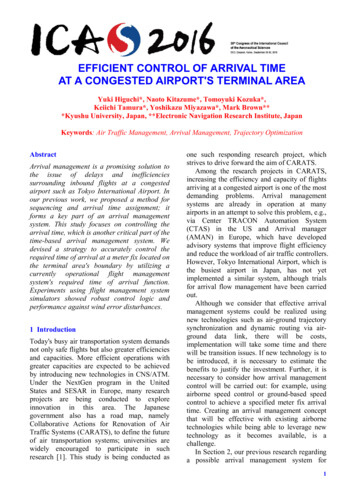
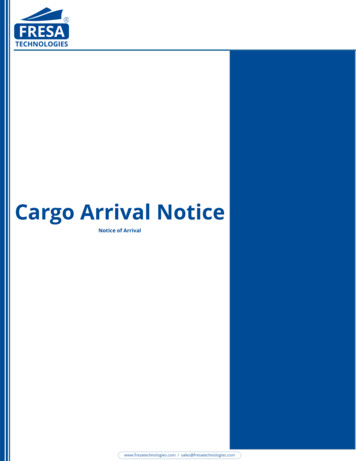
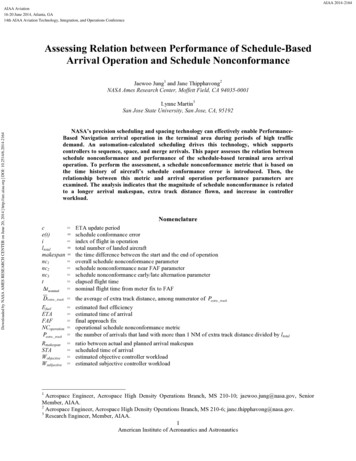
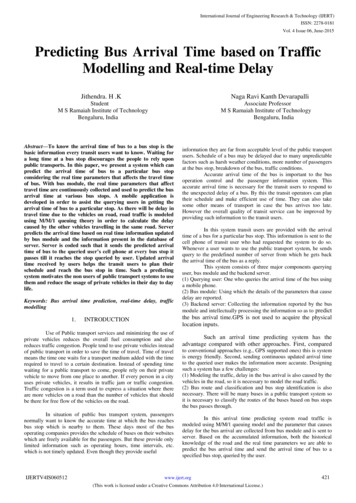
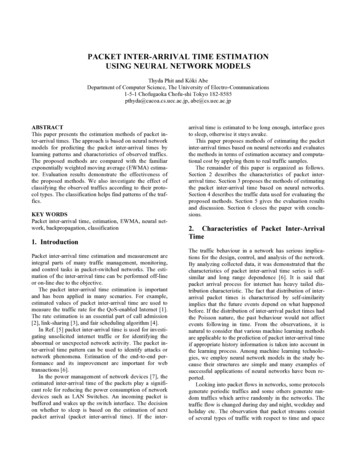
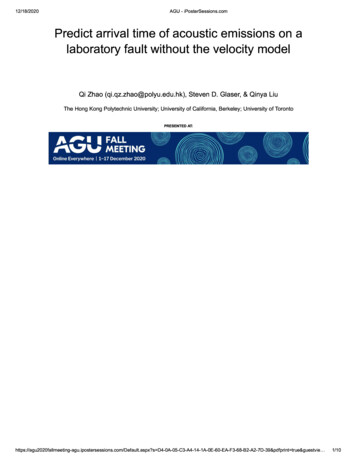
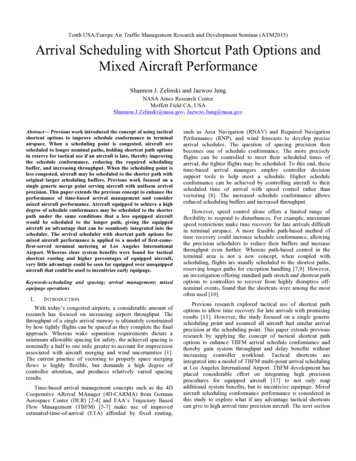
![Chap3 Airline Economics[2] - George Mason University](/img/36/chap3-airline-economics-5b2-5d.jpg)

